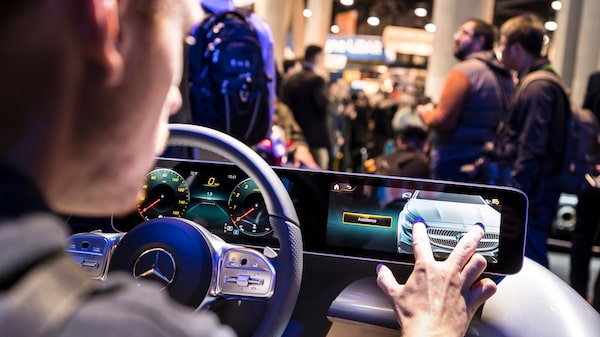Automakers and associated firms have a sizable presence at the annual CES, one of the largest technology expos in the world. Many of the most innovative and eye-grabbing developments now emanate from their booths and pavilions.
Here’s a sampling of some of those offerings – the innovations that turned heads and grabbed eyeballs at CES this week.
Mercedes refreshes its interfaces

Mercedes-Benz showed off its revamped MBUX user interface at CES.
Mercedes-Benz is revamping the technological features of its cars in a big way, starting with the 2020 CLA Coupe. With an update to its MBUX interface, the car will have better voice controls, intelligent interior lighting and the ability to connect to wearable fitness trackers and smartwatches.
On that last point, the car will be able to recommend settings depending on its driver’s current physical state. If, for example, it detects an elevated heart rate, it can suggest turning on ambient lighting and a soothing music playlist.
“It’s the ultimate wearable,” said chief executive Ola Kallenius at the Mercedes-Benz press conference.
MBUX also boasts an improved AI voice-assistant, which is now able to answer complex queries such as, “Find Japanese restaurants nearby with at least a three-star rating on Yelp that are kid-friendly.” The upgrade comes via a partnership with California-based speech-recognition provider SoundHound.
Mercedes-Benz is also expanding its partnership with What3Words, a London-based company that uses phrases instead of GPS coordinates to power its navigation system.
The company has mapped the entire world into 57 trillion squares, each measuring three square meters. Every square has its own unique three-word descriptor – the CN Tower in Toronto, for example, is select-threaten-shelters – which the company says is easier to remember than traditional addresses with street names, numbers and postal codes.
The company also says its system is more accurate because it can pinpoint locations to within three metres.
Mercedes-Benz first added What3Words to its A-Class cars last year. The voice-activated feature will be available in all cars with the MBUX interface, which will eventually roll into additional models.
“It’s a nice solution that narrows down the position,” said senior software engineer Robert Bruchhardt in an interview. “It doesn’t hurt to keep it in because it doesn’t make the system more complex.”
Urban air bus
The Bell Nexus, a vertical-takeoff vehicle, is scheduled for testing later this year.STEVE MARCUS/Reuters
If capturing attendees' attention was the ultimate goal, then Texas-based Bell Helicopter was the easy champion of this year’s CES thanks to the Nexus, a giant, six-rotored flying machine parked at the company’s booth.
Looking like a cross between an oversized drone and something out of a Terminator movie, the Nexus is Bell’s concept of an air bus – a five-seated vertical-takeoff vehicle that flies a set route.
Testing is scheduled to being later this year, and the company plans to be up and running in a handful of major cities by the mid-2020s.
Bell says the Nexus will require less maintenance than a standard helicopter thanks to its hybrid electric-powered rotors. The ultimate plan is to be fully electric, as well as autonomous.
Self-riding motorcycle

BMW's self-riding R 1200 GS motorcycle.Enes Kucevic
Self-driving cars are old hat at CES by now, but how about self-riding motorcycles? BMW’s Motorrad division had attendees talking with its demonstration of the R 1200 GS, a bike that can start, accelerate, perform cornering manoeuvres, slow down and stop all by itself.
The car company insists it isn’t just a gimmick. The bike, which uses an advanced gyroscope to determine how much it is leaning, will provide insights into riding dynamics that can help riders recognize dangerous situations and master difficult maneuvers.
BMW thus believes the experimental self-riding bike could be used to train riders, although it probably won’t enter production for at least another few years.
Better-looking sensors

Magnetti Marelli's Smart Corner headlights.Peter Nowak
Italy-based lighting-systems maker Magnetti Marelli believes the move to autonomous driving, and all the necessary sensor additions that entails, is making cars look unseemly. The company believes the solution is its third-generation Smart Corner, a light module packed with all the technology needed for autonomous driving.
The Smart Corner houses radar, solid-state lidar – a sensor that scans the environment with laser pulses – a regular camera and a thermal-imaging camera. The module also has LiFi, an emerging technology that uses light waves rather than radio waves to transmit data.
“They’re poking holes all over the vehicle to put sensors in there,” said Bill Grabowski, head of innovation and technology, in an interview. “We’re integrating it so that it’s aesthetically pleasing.”
The module is currently in predevelopment, with the company expecting it to be in cars by 2022 or 2023. Grabowski says that combining all the sensors into one package will lower their overall cost, as well as the weight of the vehicle – factors that will inevitably lead to lower prices for consumers.
The writer was a guest of Mercedes-Benz. Content was not subject to approval.
Shopping for a new car? Check out the new Globe Drive Build and Price Tool to see the latest discounts, rebates and rates on new cars, trucks and SUVs. Click here to get your price.
Stay on top of all our Drive stories. We have a Drive newsletter covering car reviews, innovative new cars and the ups and downs of everyday driving. Sign up for the weekly Drive newsletter, delivered to your inbox for free. Follow us on Instagram, @globedrive.